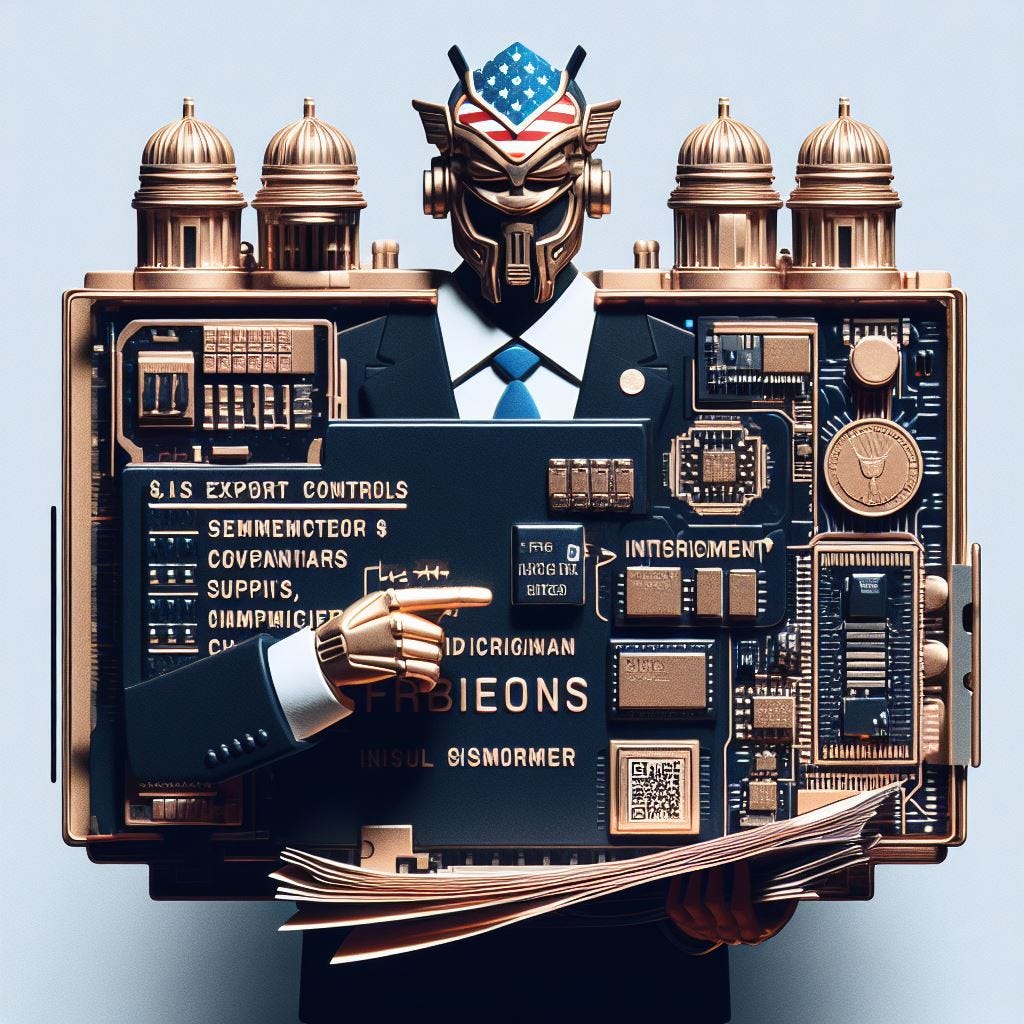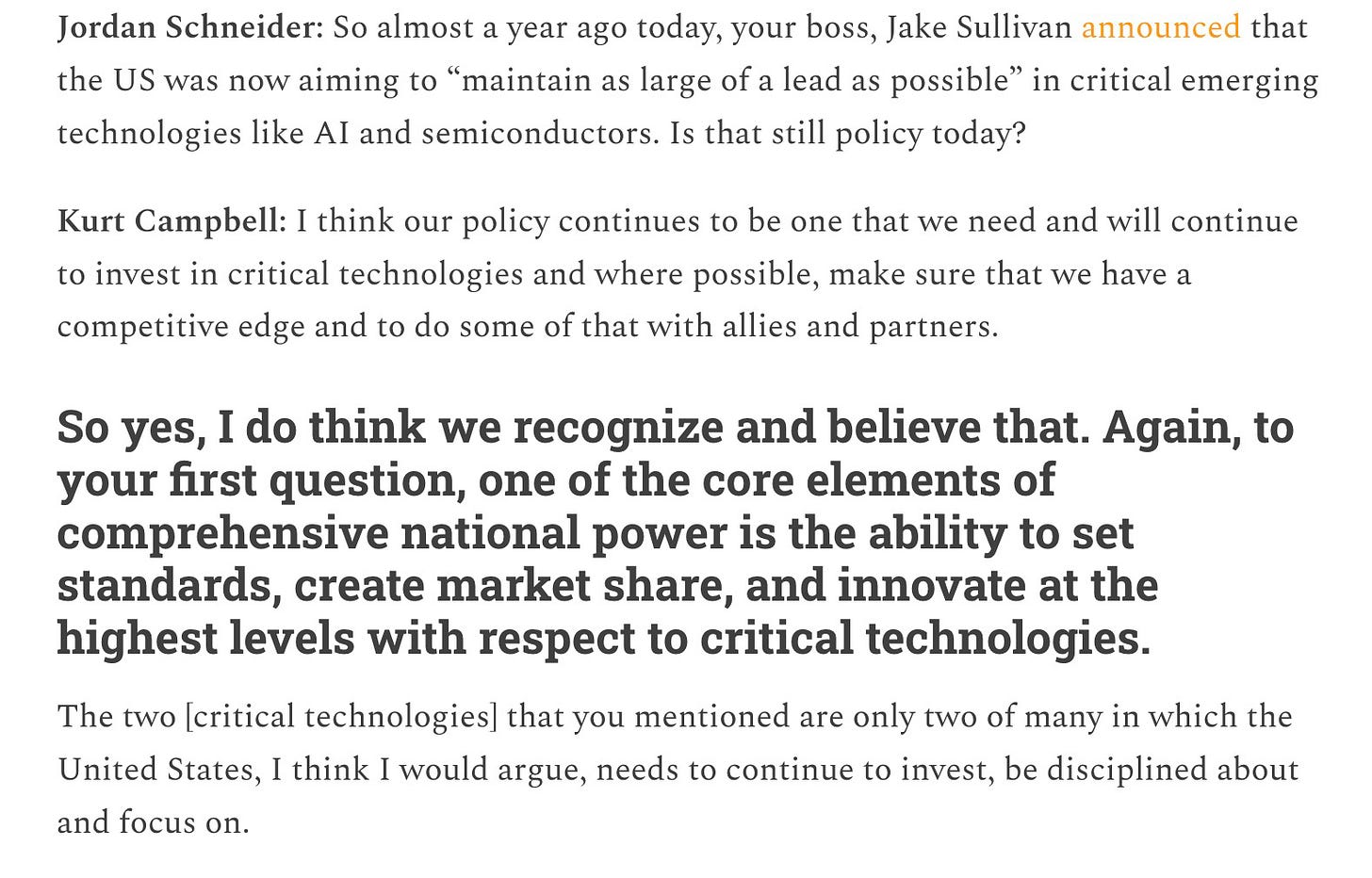How Oct 7 Went Down, AI Avatars, Farewell My Concubine
What it takes to pull together the most significant export control in a generation
Given that powerful firms with real domestic leverage like Intel and NVIDIA stand to lose out to tightening controls, perhaps what’s most remarkable about the October 7 restrictions is that they even happened in the first place.
When Trump started flailing against China tech toward the end of the term, we ended up with Xiaomi getting blacklisted and Trump playing deranged M&A banker for TikTok to Oracle and Walmart. The Biden administration, in contrast, was able to craft something technologically literate, legal, and big enough to matter. To explore just how the controls came into being, I’m running a guest piece by Eric Slesinger, published in December of last year. He spent several years in the US government before founding this year 201 Ventures, an EU-focused defense tech VC. He’s hosting the first European Defense Tech Summit in Madrid next week. Ask him for info if you’d like to attend!
Eric Slesinger—How Oct 7 Probably Went Down
The press has reported lately on US export controls and sanctions on Chinese semiconductor companies, suppliers, and intermediaries. Left out of the coverage was — what I presume to be — the small team inside the US government that’s driving this effort.
I don’t have inside knowledge on who this team is, or where they live in the organizational tangle that is the United States federal government — but I have some guesses about how they work.
First: these teams are special creatures. They’re rare, fleeting, and usually a product of individual personalities just as much as policy or funding (both prerequisites, to be sure). They’re driven by zealots who know how to work the system. The team leader is undoubtedly a mensch.
Second, some characteristics of high-performing bureaucratic teams like this one:
Top cover. Prerequisite number one, always. Given this team’s work, it’s probably at the White House (NSC or OSTP). This top cover is a get-out-of-jail-free card: any dust-ups, pissed-off agency heads, flakey lawmakers, upset ambassadors — they all get smoothed over with good top cover.
Default apolitical. Even if led by political appointees, these teams tend to work on apolitical issues (think counterterrorism). The less political the teams are, the faster they can run.
Speed. They jolt the system with speed. Speed is central to the culture of these teams, and the sense of urgency behind everything gets things done. Antibodies in the system that can’t move fast enough get bulldozed and lose.
Interagency experts. The hardest part of government action is the interagency process (government speak for coordinating across the government, usually for defense/diplomatic/national security matters). These teams excel at it, preempting arguments, leveraging influence and power appropriately, and pushing their vision and sense of urgency through this coordination process.
Recruits ringers. The government has broad hiring authority to bring in the best of academia and industry to consult on these efforts. Whereas the “retired in place” (RIP) government people see outside experts as a threat, these teams see opportunity to bring the best brains on board.
Avoids press. The fastest way to kill these teams is to publicly elevate certain people over others, and that’s always how the profile pieces go.
The team behind this semiconductor work is precise and brutal. When you see coordinated action like this, with speed like this, without names like this, know there is likely a small team in an interior office of the Eisenhower building that’s working long nights to get it all done.
Jordan—October 7 Semiconductor Controls, One Year On
The announcement of the October 7 restrictions last year was a rare premeditated geopolitical bombshell. As I argued in a piece in Noema last year,
Through moves like these, combined with policy efforts to boost domestic industry and innovation, the US is doing whatever it can to preserve and expand its edge in critical technologies. The CCP’s deep commitment to technological self-reliance, however, puts the two nations at loggerheads. These new export controls, then, solidify a major shift in US-China relations that will define the trajectory of this relationship for years to come.
Combining sophisticated technical limits with novel countrywide restrictions and new policy levers like the “US persons” language, the US government took a significant first step in shaping the long-term trajectory of the Chinese semiconductor industry. And that development — coupled with Jake Sullivan’s declaration that US policy on emerging technologies going forward with China wasn’t just to stay ahead but to “maintain as large of a lead as possible” — raised expectations that there was more to come on the “protect” side of the ledger. Alan Estevez, Under Secretary of Commerce for Industry and Security, at an event at CNAS just weeks after the regulation, made clear that more controls were on the way.
Even so, we have not seen the fruits of any other major efforts to expand aggressive export controls into other technologies. Outbound investment screening has been delayed and seemingly dramatically narrowed from its initial ambition. Even on the semiconductor side, as we’ve covered extensively on ChinaTalk, the remaining loopholes have allowed Chinese firms to achieve strategically significant advances in chip manufacturing.
Dating back to at least the balloon saga, the Biden administration has seemed to turn away from executing the aggressive version of the “as far as possible” logic on tech controls in service of “putting a floor” on the relationship. See, for instance, Kurt Campbell’s careful answer to my question of where we are one year on. Tellingly, he did not at all reference controls as key to the strategy of outpacing Chinese tech.
Emily Benson—AI Avatar Takeover
Zeyi Yang has a new piece in MIT Technology Review that looks at the strange and surreal world of Chinese 24/7 influencers shilling products in never-ending livestreams. But these influencers are not human. In a major step forward in deepfake commercialization, these AI avatars cost about $1,000 to generate but can work days, nights, and weekends to sell products, performances, and even political agendas.
One feature of avatar hosts is that they can outperform some human hosts, whose skills can vary. Chen Dan, the CEO of Quantum Planet AI, which sells these technologies to corporate clients, notes that two or three human streamers out of ten contribute to 70 to 80% of total sales, but that a “virtual livestream host can replace the rest — six or seven streamers that contribute less and have lower ROI rates.”
While many of these avatars look uncannily human, our inability to distinguish humans from avatars raises an uncomfortable truth: we did not get here overnight. For instance, FaceTune, launched in 2013, offers users a literal “glow up” that enhanced human features. Snapchat released the first augmented reality filters in 2015 when it acquired Ukrainian startup Looksery, normalizing the use of extreme filters in everyday use, even among children. These tools were harbingers of the job-automating effects these apps would have not only on photographers and artists but on influencers themselves, who would perpetuate their own prophetic downfall.
One of the most profound effects of “the age of Instagram face,” as The New Yorker dubs it, is that normalizing filters à la Kardashian has desensitized us to faces that look so perfect. Over time, this anesthetization to a heavily filtered reality has further obscured our ability to discern real from fake. In true Beria form, we may see that the influencer has led to its own execution.
Jordan—Farwell My Concubine 霸王别姬 in 4K
This week I went to Film Forum to catch a screening of an uncut 4k showing of Farewell My Concubine, the consensus greatest Chinese film of all time.
A second showing in a crowd that knew the film well was perhaps even more heartbreaking, with the audience holding their breath and sighing in anticipation of the particularly devastating scenes. The audience gave me more of an appreciation for the small bits of humor scattered in. And the visuals on a real screen are heartstoppingly beautiful.
However much we focus on this newsletter about strategic competition and technology, this movie serves as two important reminders for policymakers:
First, whenever trying to think through the mindset and motivations of the current leadership generation, it should never be far from analysts’ minds how deeply Xi and his cohort were personally shaped as teens by trauma from the Cultural Revolution.
And second, the scope of the movie reminds you just how staggering was the amount of chaos and terrible governance the Chinese people had to put up with in the twentieth century up and through Mao.
It’s showing for another week. I really encourage you to go.






